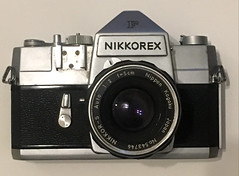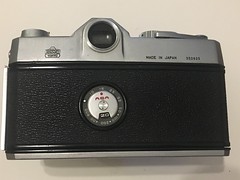Nikkorex F

|
| image by Film Shooter (Image rights) |
Nikkorex F, made by Mamiya for Nikon, also sold as Nikkor J. Introduced in 1962, it was the first production single-lens reflex camera with the vertically travelling metal Copal Square shutter. The Ricoh Singlex, also sold as Sears SL 11 is a later version of substantially the same camera, with different trimmings. The camera is branded as one of the budget Nikkorexes, but is vastly superior to the true Nikkorexes in every way, with solid metal construction, interchangeable lenses, and an early version of what was to be a highly revolutionary shutter. In essence, the camera is an intermediate between the Nikkorexes and the Nikons. It lacks the deluxe features of the F-series such as interchangeable finders, while having the same mount and arguably a better shutter than the original F. In some ways, it is a predecessor to the Nikomat/Nikkormat budget models that would come later.
Contents
Physical description
The camera is physically very substantial, being heavier and larger than, say, the Pentax Spotmatic from a few years later; this is a common thread among Mamiya's SLR's, and in fact in some ways it resembles a slightly bulkier Mamiya Prismat NP. The lens assembly is off-center on the front of the camera, with a large pentaprism housing (thus immediately differentiating this camera from the other Nikkorexes, with their porroprism finders and off-center eyepieces) marked with a large trapezoidal "NIKKOREX" badge immediately above the lens, and a black-bordered "F" above that.
The controls are generally conventional. On top of the camera, there are a large speed selector dial (the shape of which varies over the lifetime of the camera) with a stud for the accessory meter, the shutter release, film advance, exposure counter and rewind knob. The film-plane is indicated with the conventional mark on the top plate.
On the right side of the lens mount housing, a small control sticks out. Sliding this down stops down the aperture and previews depth-of-field. Next to this on the camera front is the self-timer lever (which also varies in design), and above the self-timer, an oddly-placed cold shoe to attach the very large accessory meter as shown in the main image. Some very small electronic flashes with pivoting heads and PC sync could theoretically be mounted to this, but it is not its intended purpose. Some examples have the mounting shoe attached with visible screws, and on other examples it appears to be attached in some other way.
The back has its own latch; pulling the rewind knob out does not release it. Above the latch are two PC ports for M and X sync. On the back, there is a film-type reminder, which has one dial for the film speed (10-800 ASA) and an inner dial with the numbers "20" and "36" marked twice, once with a red and then with a black background. The number refers to the two commonly available lengths of a 35mm roll at the time (24-exposure rolls existed even then, however). The background on the inner dial is probably to remind the photographer what kind of film is in the camera; for instance, red could indicate color and black could indicate b/w.
The viewfinder has a Nikon standard circular eyepiece with threading for adding accessories such as an eye-cup or a prescription diopter to compensate for bad eyesight--in fact, both can be mounted at once.
Lens mount
The camera has a standard F-series bayonet mount. On its own the camera possesses no means of reading the aperture "shoe" standard on the contemporary F-lenses (the small slotted piece of metal that sticks out of the aperture ring and informs the camera of its position.) However, the accessory meter can read both it and the shutter-speed dial. The camera does, however, automatically stop down and reopen the aperture when releasing the shutter. Mirror lock-up is not available in normal use, although a photographer intent on eliminating mirror shake may use the self-timer for this purpose, as the mirror is locked up and the aperture is stopped down as soon as the timer begins running.
The default kit lens appears to have been the (pre-AI) Nikkor-S Auto 5c 1:2, a seven-element normal lens also sold with the early Nikon F. This is an exceptionally sharp, color-corrected lens with good low-light performance, recognizable by its almost-flat front element and metal focusing ring. It has color-coded F/stops like many Nikon SLR lenses, which simplifies the design of the depth-of-field scale. As this is a comparatively early f-mount camera, more than a decade before auto-indexing lenses, the camera does not require a certain subset of Nikkor lenses, and can accept both auto-indexing (AI) and pre-auto-indexing (non-AI) lenses. Practically any Nikon lens that allows both manual focusing (even if they possess auto-focus couplings) and manual control of the aperture (practically all Nikkors except for the budget "G" series[1]) can work with this camera, though it is possible some unusual lenses may be obstructed by the physical shape of the camera.
It is remarkable to find such an early camera that can mount such a variety of pro-grade and high-end consumer-grade lenses, though it should be remembered that this is mainly possible because the camera does not communicate with the lens at all except via the aperture linkage.
Shutter
At a time when the focal-plane shutter had existed in roughly the same form for many decades, the vertical-moving Copal Square was a welcome change, with collapsing metal blinds rather than delicate and degradable cloth curtains. Mechanical Copal Square shutters tend to be resistant to falls and vibration, and give X-sync at higher speed (1/125th, in this case) due to the increased speed at which the blinds move and the shorter distance which they travel (across the height rather than the width of the frame). Shutter speeds above 1/125th are in green on the dial, while 1/125th-1 second are marked in orange and B is marked in white.
The self-timer intervenes in the exposure process after the mirror has been raised and the aperture has been stopped down, but before the shutter has been fired. The timer can be set at less than the maximum time, and in fact, a photographer concerned about mirror slap can charge it slightly, so that there is about half a second between the mirror raising and the shutter firing. The timer is controlled by the shutter-release button, and it can be both charged and released without cocking the shutter, unlike some cameras' self-timers.
|
Conclusion
While this camera was a budget model at the time, it is a little hard to find now, and can be expensive if sold online. However, cheap examples from garage sales and the like may be well worth buying, especially given the large number of excellent lenses that it can take, as well as the outstanding classic lens it is liable to come with. As the shutter is very often still in working condition, it is possible to have a fully mechanical f-mount SLR in perfect condition without the expense of a Nikon from the same era. It has no battery to leak acid into the baseplate, no tediously delicate mechanical linkages associated with in-viewfinder displays, no threading in the lens mount to wear out over time; in short, there is very little other than the shutter that can realistically fail under normal circumstances on the Nikkorex F.
Technical specifications
- Type: 35mm SLR
- Manufacturer: Mamiya for Nippon Kougaku
- Lens mount: Nikon F mount
- Shutter: Copal Square vertical travel metal-blind mechanical focal-plane shutter
- Shutter speeds: 1/1000th-1 second, B
- Flash sync: F, X at 1/125th.
- Exposure: Manual, designed to use clip-on accessory meter.
- Viewfinder: SLR with fresnel focusing screen and split-screen device
Changes in manufacturers inferred from external and structural changes
It is widely known that Nikkorex F can be classified into two types, early type and late type, after serial number 400000 or so, based on the characteristics of their exterior parts. This is believed to be due to the fact that when the manufacturer was changed from MAMIYA to Aires, the exterior parts inherited from MAMIYA were used up, and Aires procured parts on its own.
Apart from these external characteristics, we were also able to confirm differences in mechanical characteristics. One of the major changes is the number of anti-reversal latches on the winding shaft. In terms of external features, we compared serial No.36xxxx and No.39xxxx, which were classified as the early type. As a result, it was confirmed that No.36xxxx has one latch, while No.39xxxx has two latches. It was also confirmed that the Ricoh Singlex, which has the same basic design and is known to have been manufactured by Aires using parts from the Nikkorex F, also has two latches.
This indicates that even though the unit was classified as an early model, there is a possibility that it was manufactured by Aires.
Links
- Nikkorex F at Nikon's History & Technology site
- The Nikkorex F at Cameraquest
- The black Nikkorex F at Cameraquest
- The Nikkorex F with meter at Rick Housh's site
- Nikkorex F and clones at Rick Housh's site
- Mamiya Prismat and Nikkorex F at Herron's site
- The first Nikon SLR's at Photography in Malaysia
- The Nikkorex F at Peter Lausch's site
- The Nikkorex F at Takojin's site
- The Nikkorex F at nikomat.org
- Nikkorex F Instruction manual - English at Butkus.org
| Nikon 35mm SLR Cameras | |
|---|---|
| Nikkorex F | Nikon EL2 | Nikon EM | Nikon F | Nikon F2 | Nikon F3 | Nikon F4 | Nikon F5 | Nikon F6 | Nikon F50 | Nikon F55 | Nikon F60 | Nikon F65 | Nikon F70 | Nikon F75 | Nikon F80 | Nikon F90 | Nikon F90X | Nikon F100 | Nikon F-301 | Nikon F-401 | Nikon F-401S | Nikon F-401X | Nikon F-501 | Nikon F-601 | Nikon F-601M | Nikon F-801 | Nikon F-801s | Nikon FA | Nikon FE | Nikon FE2 | Nikon FE10 | Nikon FG | Nikon FG-20 | Nikon FM | Nikon FM2 | Nikon FM2n | Nikon FM3A | Nikon FM10 | |
| Nikomat / Nikkormat | |
| EL | EL2 | ELW | FS | FT | FT2 | FT3 | FTN | |
- ↑ often derogatorily said to stand for "gelded" by photographers

